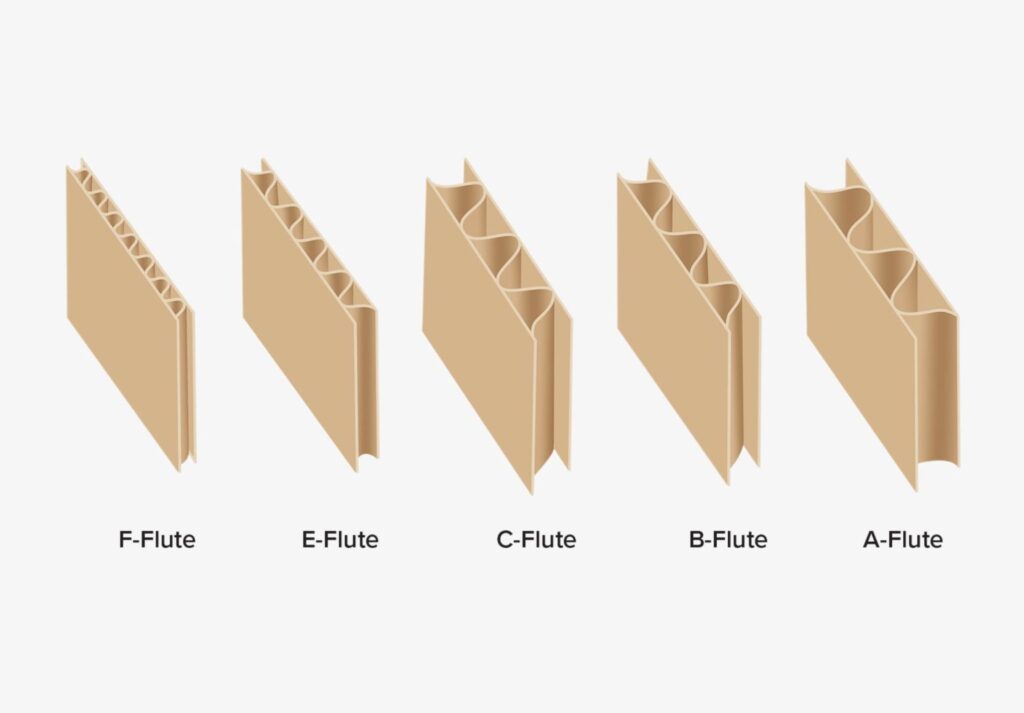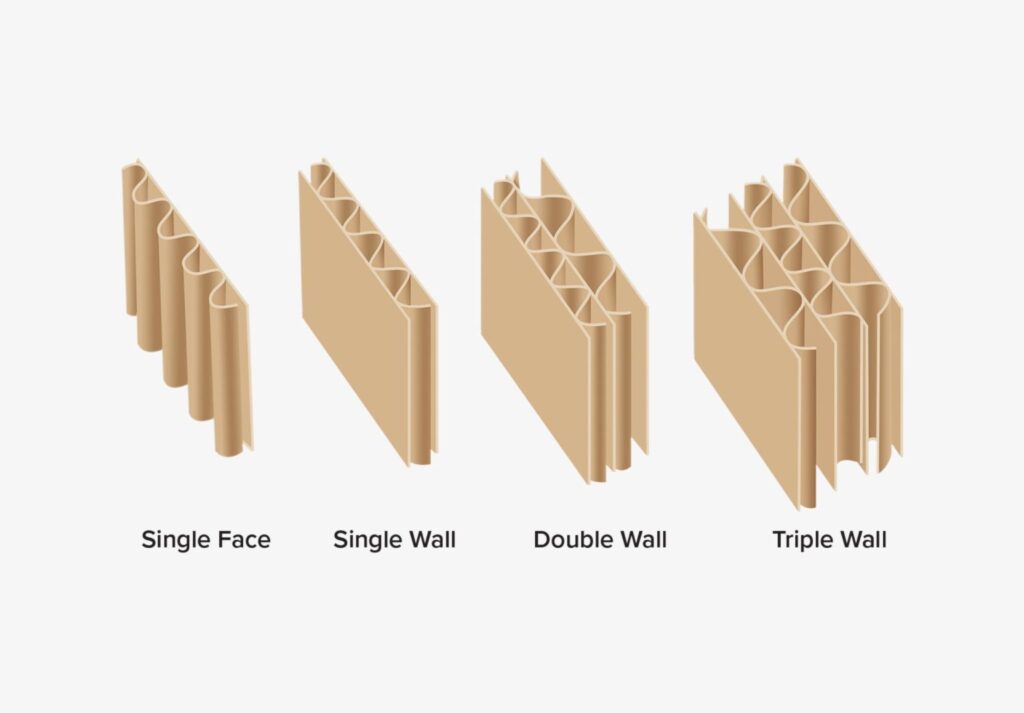1: Základy vlnitých krabic
2: Styly vlnitých krabic
3: Druhy vlnité lepenky
Vlnitá lepenka se dodává v různých typech, jako je jednostranná, jednovrstvá, dvouvrstvá a třívrstvá, přičemž každý z nich nabízí různý stupeň ochrany. Volba závisí na hmotnosti produktu a požadované úrovni ochrany.
Vlnitá drážka je podobná linerovým deskám, až na konstrukci.
Vlnitý materiál poskytuje vašemu obalu tlumení, pevnost a odolnost proti stlačení v závislosti na různých třídách, což umožňuje ještě větší přizpůsobení vašeho obalu. Než se však podrobně podíváme na každou třídu materiálů, podívejte se na naši tabulku vlnitých materiálů pro rychlé vizuální srovnání:
 A-flétna – 1/4” je první typ vlnité drážky. Tato třída drážky má nejvyšší ochranné a tlumící vlastnosti. Velmi dobře zvládá kompresi a stohování a často se používá k balení křehkých předmětů.
A-flétna – 1/4” je první typ vlnité drážky. Tato třída drážky má nejvyšší ochranné a tlumící vlastnosti. Velmi dobře zvládá kompresi a stohování a často se používá k balení křehkých předmětů.
B-flétna – 1/8”. Tato flétna se zdá být mnohem tenčí než ostatní, ale stále je poměrně pevná, s vynikající odolností proti propíchnutí a rozdrcení. Flétna ve tvaru B má vynikající všestranné vlastnosti pro různé obaly nebo jako doplňkový materiál pro výplň a dělení. Má dokonce i plošší povrch pro kvalitnější tisk a snadné vysekávání.
C-flétna – 3/16” je flexibilní a jeden z nejuniverzálnějších druhů vlnité lepenky pro krabice. Má průměrnou odolnost proti tlaku, stohovací pevnost a tiskové vlastnosti. Pravděpodobně jste viděli, že se vlnitá lepenka C používá pro přepravní krabice, ale také pro balení skla, mléčných výrobků a nábytku.
E-flétna – 1/16” se obvykle nepoužívá pro přepravu. Tloušťka E-vlny je u ostatních typů vln na tenčí straně, takže se často používá jako alternativa pro skládací kartony z lepenky. E-vlnu však můžete i nadále použít pro kosmetiku, křehké sklo, keramiku a další malé a jemné výrobky. E-vlnu má vynikající pevnost v tlaku, odolnost proti rozdrcení a relativně plochý povrch pro vysoce kvalitní tiskové aplikace.
F-flétna – 1/32” má ochranné vlastnosti podobné jako E-Flute, ale s ještě hladším povrchem pro vysoce kvalitní tisk. V americkém rychlém občerstvení se F-Flute běžně používá pro obaly ve tvaru mušle, ale v Evropě je tento druh vlnitého flutingu standardní volbou pro speciální a maloobchodní obaly.
4. Tloušťka vlnité lepenky
Nyní, když jsme si probrali různé typy papírových linerů a stupňů flétny, je čas podívat se na tloušťku! Níže je uveden přehled standardních dostupných tlouštěk:
Vložková deska – „Líc“ dřevovláknité desky. Na tuto desku nalepíte flétnu.
Jedna tvář – Skládá se z jedné krycí desky s nalepenou drážkou viditelnou na jedné straně.
Jednostěnná – Nejběžnější tloušťka. Dvě vložkové desky s mezi nimi nalepenou vroubkovanou dřevovláknitou deskou.
Dvojitá stěna – Tři listy krycí lepenky a dvě drážkované dřevovláknité desky mezi nimi.
Trojitá stěna – Čtyři listy krycí lepenky a tři drážkované dřevovláknité desky mezi nimi. Tato varianta snese větší hmotnost až do téměř 136 kg, ale je méně flexibilní.

Při bližším zkoumání dvojitých a trojitých stěn jsou s těmito možnostmi možné různé kombinace jakostí drážek. Mezi standardní kombinace v oboru patří:
AC flétna – Kombinace dvou nejochrannějších druhů vlnité lepenky. AC Flute je vynikající, pokud potřebujete extra ochranu při náročných přepravních a manipulačních procesech.
Flétna před naším letopočtem – Tato kombinace je vynikající všestrannou ochranou, která poskytuje vysokou úroveň ochrany při přepravě a je běžná u přepravních krabic.
EB flétna – Poskytuje vynikající pevnost a bezpečnost při přepravě, zatímco vnější E-fléta umožňuje vynikající, vysoce kvalitní tiskový povrch.
